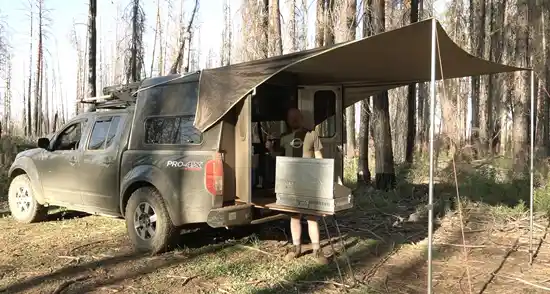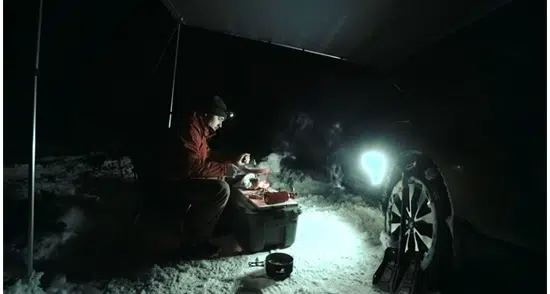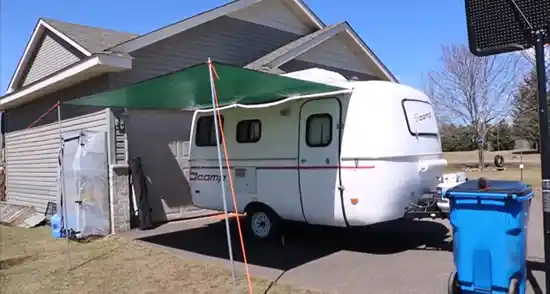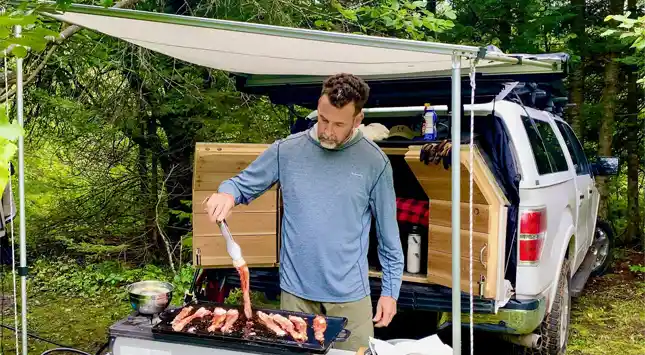Last Updated on September 25, 2023
RVers love cooking different meals while on the road, but some are concerned about how safe it is to cook under their awning. Many people have argued that grilling or other meals under RV awnings may damage the fabric, cause smoke stains, and even lead to fires. So can you cook in an awning?
Actually, an awning is a kind of sunshade or rain shelter that is commonly attached to the side of an RV. It’s made with fabric that is usually water-resistant and UV-resistant. Many RV awnings are also equipped with lights, so you can enjoy your outdoor space even after the sun goes down.
Let’s get back to the point at hand, does it really make a difference if you cook under an outdoor living space awning? This article will explain in brief detail. Let’s dive in.
Can You Cook In an Awning of an RV?

The exact answer is YES. Many people choose to do this because it provides them with a nice shady spot to cook their meals. It’s important to keep in mind that you’ll need to be extra careful. Here are some things to consider:
1. Maintain Awning Height
This is key when cooking in an RV. If the awning is not high enough, heat and smoke will billow inside the RV, setting off the fire alarm and making it difficult to see. Low awnings can block vents and cause the buildup of carbon monoxide.
To avoid these problems, be sure to set up the fabric at least 8 feet off the ground. Depending on the size of your RV, you may need to raise the retractable awning higher.
2. Clear Your Surroundings
Ensure that your surroundings are as clear as possible. This means keeping flammable materials like paper and leaves away from the area, as well as making sure there is nothing overhead that could catch fire.
Also, you should cut down small trees, shrubs, and other growth around your RV to create an effective fire break. To be safe, clear a larger area than the size of your awning while you’re at it.
3. Clean Your Grill
A build-up of food residue and grease can cause problems with both the taste and quality of your food. It can also be a fire hazard. To clean your grill, start by removing any debris from the surface. Then, use a wire brush to scrub away any remaining residue.
Finally, rinse the grill with warm water and dry it thoroughly with a clean cloth. By keeping your grill clean, you’ll ensure that your food tastes great and that you’re cooking in a safe environment.
4. Observe the Wind

When cooking under an awning fabric, the high wind can be a challenge. If it’s too windy, smoke and heat will be blown around, making it difficult to cook. Strong winds can also cause awnings to collapse. Therefore, always check the weather forecast before preparing food.
If the wind is higher than 20 mph, it’s best to wait for another day. You should also secure any items that are loose around the RV tent to prevent them from blowing away.
5. Place Your Grill Properly
Make sure that you place your grill on a level surface. This will help to prevent it from tipping over and causing an accident. It’s also important to place the grill a safe distance away from the RV.
For a charcoal grill, that’s at least 3 feet and for a gas grill, that’s at least 5 feet. It can also depend on RV awning dimensions. Just be sure to give yourself enough room to cook without being too close to the RV.
6. Monitor the Temperature
The ideal temperature for cooking is between 225 and 300 degrees Fahrenheit. If the temperature gets too hot, food can start to smoke or even catch fire. If it’s not hot enough, the grill may not be good enough.
For most RV awnings, the ideal grilling temperature is around 250 degrees, so it’s important to keep an eye on the temperature if you’re doing so under one. One good way to do this is to use an oven thermometer.
7. Have a Fire Extinguisher Handy
It’s always a good idea to have a fire extinguisher on hand when cooking. If a grease fire does start, you’ll be glad you have it. Be sure to read the instructions on how to use it before you need it.
In general, you should aim the extinguisher at the base of the fire, not at the flames. Also, be sure to check the expiration date on your fire extinguisher and replace it as needed. And, of course, never leave a fire unattended.
8. Be Prepared for Rain
If you’re cooking in an RV awning during the rainy season, be prepared for wet weather. Make sure that you have a tarp or other waterproof covering to protect your grill from the rain.
Although heavy rain, high winds, and thunderstorms are all dangers associated with grilling outside, so always be sure to check the weather forecast before you begin the meal.
By following these simple tips, you can enjoy outdoor cooking without any worries. Just be sure to take all necessary precautions to ensure your safety.
What are the Factors That Contribute to RV Delamination?
Factors of rv delamination can include water damage, moisture intrusion, poor construction techniques, and prolonged exposure to sun and heat. These factors weaken the adhesive bonds in the RV’s sidewalls, leading to separation of the layers and delamination. Regular maintenance, proper storage, and addressing any water leaks promptly can help prevent the occurrence of this issue.
What Are Some of the Challenges of Cooking In an Awning?

While cooking in an awning can be a fun and convenient way to prepare meals while RVing, there are a few challenges that you should be aware of. Below are a couple of complexities associated with preparing meals in an awning:
i) Heavy Rain: One of the challenges of grilling in a trailer awning is heavy rain. When the rains come heavy and fast, they can quickly overwhelm the structure and cause it to collapse.
They can also make it harder to control the heat of the stove. As a result, it is important to be careful when cooking in RV awnings during heavy rain.
ii) High Winds: The wind can cause the flames to flicker and the smoke to blow around, making it hard to see what you’re cooking. High winds can make it difficult to control the temperature of the fire, making it harder to cook food evenly. And if you’re using a grill or smoker, the wind can carry away all the heat, making it impossible to cook anything at all.
iii) Sunlight Heat: The sun’s heat can make the awning incredibly hot, causing it difficult to stand near the grill stove. If you have to cook in this kind of heat, be sure to stay hydrated and take breaks often. It’s a good idea to have a misting fan handy to help keep you cool by spraying you with a fine mist of water.
iv) Lack of Counter Space: This can make it difficult to prepare food or keep things organized while you’re cooking. To make the most of the space you have, try to use small appliances and cookware that can be stored away when not in use.
v) Bug Infestations: If there are bugs in your awning, they can quickly become a nuisance. Be sure to keep an eye out for bugs and take steps to eliminate them if they become a problem. You may also want to consider using a bug zapper to help keep the bugs away.
Now that you know some of the difficulties of cooking in a motorhome awning, you can be better prepared to deal with them if they arise. While grilling under a tent may be a tricky process, it is well worth the effort to enjoy delicious meals while RVing.
Frequently Asked Questions
There are a few questions that are commonly asked about cooking under your RV’s awning. The following are some of the most frequently asked questions about this topic:
1. Can You Use a Camper Stove in a Tent?
The answer is yes, but there are a few things you need to keep in mind. First, make sure that the tent has good ventilation. Stoves produce fumes that can be dangerous if they build up in an enclosed space. Second, be careful not to tip the stove over.
Tent floors are not always level, and a spilled stove could start a fire. In order to prevent the smoke from escaping from a wood burning stove, position the stove near an opening in the tent.
2. Can You Grill In a Covered Porch?
Yes, you can. It’s a good idea to make sure the area is well ventilated and that the grill is on a heat-resistant surface.
If possible, position the grill so that it’s near an open door or window to help ensure good ventilation. And make sure you keep an eye on the fire at all times when grilling on a covered porch.
3. Can You Get CO2 Poisoning in a Tent?
Portable gas stoves and charcoal grills can be incredibly dangerous if not used correctly. In enclosed spaces like tents, the CO from the stove or grill can quickly build up and cause poisoning.
This report highlights the dangers of using these appliances in confined spaces and encourages people to use caution when using them indoors.
Conclusion
While cooking in an awning is a little tricky, it is absolutely doable with the right preparation outlined in this article. Be sure to keep an eye on the weather, use caution when grilling near high winds, and be aware of the lack of counter space. With a little planning, you can enjoy delicious meals while RVing.
We hope that now you know about “can you cook in an awning”, and how to go about it. Do let us know in the comments below if you have any more tips to share. Thanks for reading. Happy RVing.



